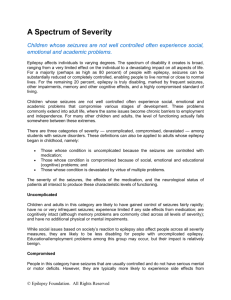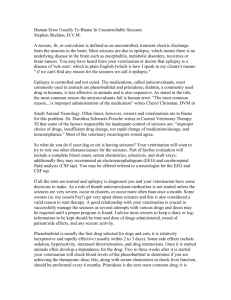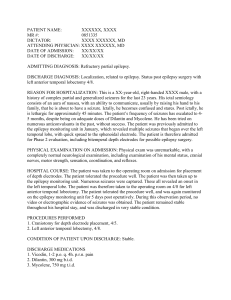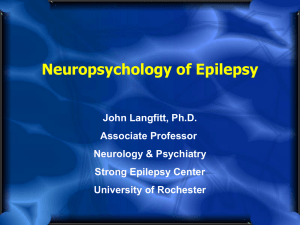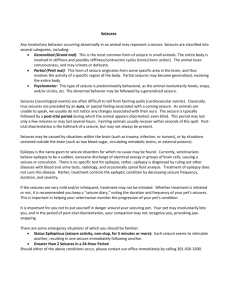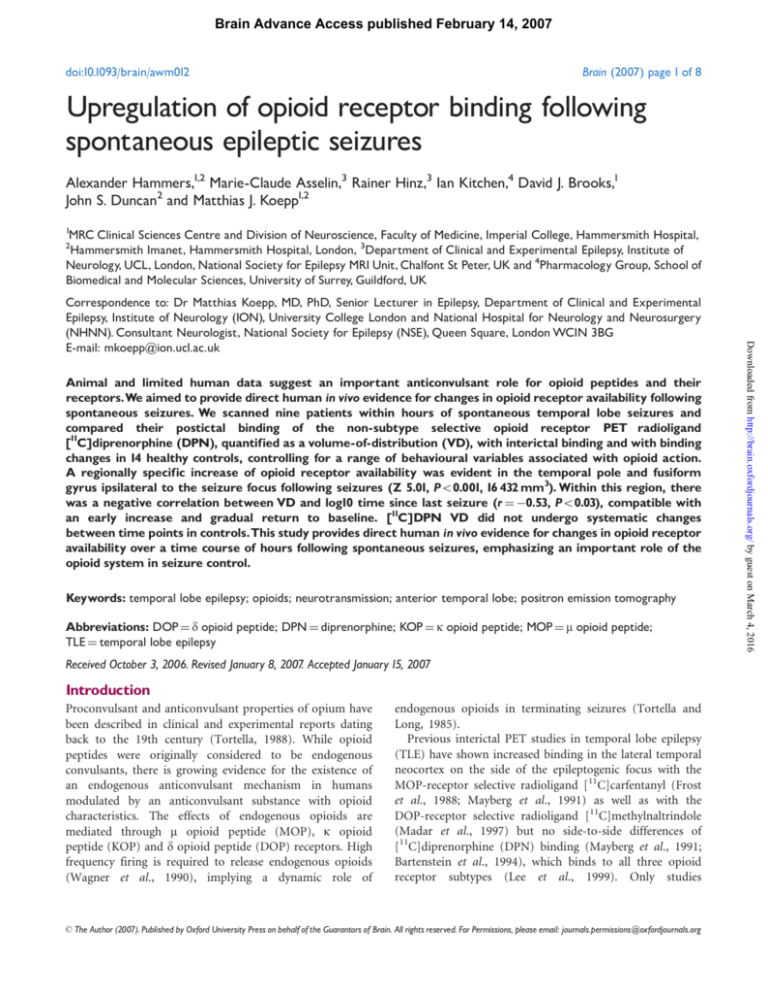
Brain Advance Access published February 14, 2007
doi:10.1093/brain/awm012
Brain (2007) page 1 of 8
Upregulation of opioid receptor binding following
spontaneous epileptic seizures
Alexander Hammers,1,2 Marie-Claude Asselin,3 Rainer Hinz,3 Ian Kitchen,4 David J. Brooks,1
John S. Duncan2 and Matthias J. Koepp1,2
1
MRC Clinical Sciences Centre and Division of Neuroscience, Faculty of Medicine, Imperial College, Hammersmith Hospital,
Hammersmith Imanet, Hammersmith Hospital, London, 3Department of Clinical and Experimental Epilepsy, Institute of
Neurology, UCL, London, National Society for Epilepsy MRI Unit, Chalfont St Peter, UK and 4Pharmacology Group, School of
Biomedical and Molecular Sciences, University of Surrey, Guildford, UK
2
Animal and limited human data suggest an important anticonvulsant role for opioid peptides and their
receptors.We aimed to provide direct human in vivo evidence for changes in opioid receptor availability following
spontaneous seizures. We scanned nine patients within hours of spontaneous temporal lobe seizures and
compared their postictal binding of the non-subtype selective opioid receptor PET radioligand
[11C]diprenorphine (DPN), quantified as a volume-of-distribution (VD), with interictal binding and with binding
changes in 14 healthy controls, controlling for a range of behavioural variables associated with opioid action.
A regionally specific increase of opioid receptor availability was evident in the temporal pole and fusiform
gyrus ipsilateral to the seizure focus following seizures (Z 5.01, P50.001, 16 432 mm3). Within this region, there
was a negative correlation between VD and log10 time since last seizure (r ¼ 0.53, P50.03), compatible with
an early increase and gradual return to baseline. [11C]DPN VD did not undergo systematic changes
between time points in controls.This study provides direct human in vivo evidence for changes in opioid receptor
availability over a time course of hours following spontaneous seizures, emphasizing an important role of the
opioid system in seizure control.
Keywords: temporal lobe epilepsy; opioids; neurotransmission; anterior temporal lobe; positron emission tomography
Abbreviations: DOP ¼ d opioid peptide; DPN ¼ diprenorphine; KOP ¼ k opioid peptide; MOP ¼ m opioid peptide;
TLE ¼ temporal lobe epilepsy
Received October 3, 2006. Revised January 8, 2007. Accepted January 15, 2007
Introduction
Proconvulsant and anticonvulsant properties of opium have
been described in clinical and experimental reports dating
back to the 19th century (Tortella, 1988). While opioid
peptides were originally considered to be endogenous
convulsants, there is growing evidence for the existence of
an endogenous anticonvulsant mechanism in humans
modulated by an anticonvulsant substance with opioid
characteristics. The effects of endogenous opioids are
mediated through m opioid peptide (MOP), k opioid
peptide (KOP) and d opioid peptide (DOP) receptors. High
frequency firing is required to release endogenous opioids
(Wagner et al., 1990), implying a dynamic role of
endogenous opioids in terminating seizures (Tortella and
Long, 1985).
Previous interictal PET studies in temporal lobe epilepsy
(TLE) have shown increased binding in the lateral temporal
neocortex on the side of the epileptogenic focus with the
MOP-receptor selective radioligand [11C]carfentanyl (Frost
et al., 1988; Mayberg et al., 1991) as well as with the
DOP-receptor selective radioligand [11C]methylnaltrindole
(Madar et al., 1997) but no side-to-side differences of
[11C]diprenorphine (DPN) binding (Mayberg et al., 1991;
Bartenstein et al., 1994), which binds to all three opioid
receptor subtypes (Lee et al., 1999). Only studies
ß The Author (2007). Published by Oxford University Press on behalf of the Guarantors of Brain. All rights reserved. For Permissions, please email: journals.permissions@oxfordjournals.org
Downloaded from http://brain.oxfordjournals.org/ by guest on March 4, 2016
Correspondence to: Dr Matthias Koepp, MD, PhD, Senior Lecturer in Epilepsy, Department of Clinical and Experimental
Epilepsy, Institute of Neurology (ION), University College London and National Hospital for Neurology and Neurosurgery
(NHNN). Consultant Neurologist, National Society for Epilepsy (NSE), Queen Square, London WC1N 3BG
E-mail: mkoepp@ion.ucl.ac.uk
Brain (2007) page 2 of 8
Material and methods
Subjects
Inclusion criteria were age 25–65 years, and refractory TLE in
patients. Exclusion criteria were concomitant neurological or
psychiatric disorders or previous brain injury, use of opioidcontaining medication within the two weeks prior to a scan, and a
positive pregnancy test.
Patients from the Telemetry Unit at the National Hospital for
Neurology and Neurosurgery (NHNN), Queen Square, London;
the Sir William Gowers Assessment Centre at the National Society
for Epilepsy (NSE), Chalfont St Peter, Buckinghamshire; a cohort
of patients who had been evaluated for epilepsy surgery, and
referrals from outpatient clinics at both the NHNN and NSE were
screened for inclusion. Out of a screened population of 1200
patients, 60 patients agreed to participate in the study, had
suitable spontaneous seizure frequencies and reliably recalled their
seizures without suffering from unobserved nocturnal seizures or
seizures which they did not recall, as verified during previous
prolonged video-EEG monitoring and/or prolonged inpatient stays
at the Chalfont Centre for Epilepsy. Low seizure frequencies were
not an exclusion criterion but reduced our chances of obtaining a
postictal scan. Frequent seizures did not exclude patients from the
study as long as they occasionally had periods of two weeks
without seizures in order to enable us to schedule an interictal
scan. Patients were informed of scheduled scanning times but also
encouraged to call the main investigator (A.H.) whenever there
was any possibility of organizing a postictal scan within 24 h. Over
four years, nine patients (four women; median age 47 years, range
32–60 years) were scanned twice, postictally within 24 h of a
spontaneous seizure (median interval 8.5 h, range 1.5–21.33 h) and
again interictally after a seizure-free interval (median 224 h/9.3
days, range 152–1344 h/6.3–56 days). Fourteen healthy control
subjects (four women; median age 41.5 years, range 26–58 years)
were recruited from acquaintances of the investigators and
scanned twice under the same conditions. The median interval
between scans was 121 (24–406) days for patients and 48 (1–101)
days for controls.
Ethical permission from the Hammersmith, Queen Charlotte’s
and Chelsea and Acton Research Ethics Committee, and the Joint
Ethics Committee of The Institute of Neurology and the NHNN,
and permission by the UK Administration of Radiation Substances
Advisory Committee (ARSAC) were obtained, and all subjects
gave informed written consent.
The diagnosis of TLE was based on history, seizure semiology,
interictal EEG features and neuropsychological examination. The
lateralization of TLE was additionally based on MRI findings and
ictal EEG when available; for ‘MRI-negative’ patients ictal EEG
was always obtained. In one case (Patient 5) where the ictal scalp
EEG was inconclusive, lateralization was based on interictal EEG
and the MRI finding of unilateral HS (Mintzer et al., 2004).
Clinical characteristics are given in Table 1.
PET data acquisition
Scans were performed in three-dimensional acquisition mode on a
Siemens/CTI ECAT EXACT3D PET camera, with a spatial
resolution of reconstructed images of 5 mm (Spinks et al.,
2000). A median dose of 183 MBq (range, 125–200 MBq) of
[11C]DPN with a median radiochemical purity of 98.4% (range,
94–100%) was injected. The median co-injected mass of
unlabelled DPN was 3.1 mg (range, 1.2–21.0 mg), corresponding
to an estimated median receptor occupancy of 0.24% (range,
0.08–1.19%), thereby fulfilling the tracer kinetics assumption.
Tomographic data acquisition was performed event-by-event,
and data were rebinned into 32 time frames. A five-min
transmission scan using a hydraulically driven 137Cs point
source was acquired prior to each emission scan. Each subject’s
head position was maintained with individualized foam holders
and monitored throughout. Subjects were rested with lights
dimmed and no external noise.
Image data were reconstructed using a reprojection algorithm
(Kinahan and Rogers, 1989) with ramp and Colsher filters cutoff
at Nyquist frequency. Measured attenuation maps were segmented
(Bailey et al., 1998) and used for model-based scatter correction
(Watson et al., 1996) and attenuation. Voxel sizes following
reconstruction were 2.096 mm 2.096 mm 2.43 mm.
Derivation of input functions
Arterial blood was continuously withdrawn for 15 min through a
22-gauge cannula in a radial artery at a sampling rate of initially
5 ml/min and measured in a BGO detection system (Ranicar et al.,
1991). Additional discrete blood samples were taken for crosscalibration, determination of the partition of radioactivity and
determination of parent fraction (Luthra et al., 1993) for the
creation of individual arterial plasma input functions corrected
for metabolism.
PET data analysis
Standardized samples of high-contrast volumes-of-interest (VOIs)
were defined directly on weighted activity images summed over
the duration of the emission scans (ADD images). These VOIs
Downloaded from http://brain.oxfordjournals.org/ by guest on March 4, 2016
quantifying receptor binding in the same subject over time
can demonstrate the role of a given receptor–ligand
interaction in a given event. PET studies have shown a
decrease in [11C]DPN binding in association cortices during
hyperventilation-induced absences (Bartenstein et al., 1993)
and lower binding in reading-associated areas during
reading-induced seizures in reading epilepsy compared to
baseline scans (Koepp et al., 1998). Radioligand binding
changes following spontaneous seizures have not been
studied.
In the current study, we used [11C]DPN PET to measure
changes in opioid receptor availability following spontaneous seizures in patients with TLE by means of a two-scan
paradigm. The first scan was performed as soon as possible
(within hours) after a spontaneous seizure; the second scan
was acquired days to weeks later after as long a seizure free
period as achievable in a given patient and served as an
intrasubject control. In addition, healthy controls were
scanned twice under the same conditions to establish the
normal fluctuation of opioid receptor availability. Large
increases of opioid receptor availability relative to the
control condition in patients as well as relative to the
controls were observed following seizures in a time
dependent fashion specifically in the temporal pole
ipsilateral to the epileptogenic focus.
A. Hammers et al.
Number Age
(years)/sex
handedness
1
2
3
4
5
6
7
8
9
Onset/ Seizures/year Postictal/interictal Treatment
interval (hours);
duration
interscan interval
(years)
41/M
28/13
lh/ambidextrous
37/F
16/21
lh
182
57/M
rh
32/F
rh
49/M
lh/ambidextrous
60/F
rh
57/M
rh
44/F
rh
21/36
42
3/29
144
27/22
24
1/59
12
5/52
108
14/30
44
11/37
42
47/M
rh
48
15/168
172d
7/152
125d
2/480
24d
1.5/192
91d
8.5/320
70d
13/1344
195d
19.5/192
406d
21.33/224
121d
6.33/264
45d
Seizures
EEG
(interictal)
EEG (Ictal)
PHT, TPM, LEV,
GBP, CLB
OXC, GBP,
CLB, DZP prn,
folic acid
CBZ, LEV, acitretin,
oxytetracycline
CBZ, VPA, LEV
SPS, CPS
Spikes L:R 24:1
L frontotemporal L HS
L
CPS, 2 GTCS L slow
No seizures
L HS
L
CPS
L mid TL
L TL
bil HS
L
SPS, CPS
R TL
R HS
R
CBZ, LTG, LEV
SPS, CPS
R TL
Only SPS
recorded
L TL/bilateral
R HS
R
LEV, TPM,
loperamide
LEV, diclofenac
SPS, CPS
L TL
L frontotemporal L HS
L
SPS, CPS
R mid TL
R TL
R
PHT, LEV, CLB prn, SPS, CPS
clonidine,
citalopram, insulin
PHT, CBZ
SPS, CPS
Bitemporal R 4 L R TL þ C4
TL spikes L:R 4:1, R TL
lTL slow
MRI/other
imaging
MRIneg
Probable
side of
focus
Spontaneous seizures and opioid receptors
Table 1 Patients’ clinical and imaging characteristics
MRIneg
R
FDG PET: slight
rTL hypometabolism
MRIneg
R
CPS ¼ complex partial seizure; EEG ¼ electroencephalogram; M ¼ male, F ¼ female; lh/rh ¼ left/right handed; d ¼ days; PHT ¼ phenytoin; TPM ¼ topiramate; LEV ¼ levetiracetam;
GBP ¼ gabapentin; CLB ¼ clobazam; OXC ¼ oxcarbazepine; DZP ¼ diazepam; prn ¼ pro re nata (if needed); CBZ ¼ carbamazepine; LTG ¼ lamotrigine; SPS ¼ simple partial seizures;
2 GTCS ¼ secondarily generalized seizures; L ¼ left; R ¼ right; TL ¼ temporal lobe; HS ¼ hippocampal sclerosis; HC ¼ hippocampus; FDG ¼ [18F]fluorodeoxyglucose.
Brain (2007) page 3 of 8
Downloaded from http://brain.oxfordjournals.org/ by guest on March 4, 2016
Brain (2007) page 4 of 8
were applied to the dynamic dataset and decay-corrected timeactivity curves computed in order to assess movement during the
scan. When movement was detected in a scan, both datasets of a
pair were movement corrected with a frame-by-frame registration
method using mutual information (Studholme et al., 1997).
Dynamic PET images, input functions and spectral analysis
(Tadokoro et al., 1993) were then used to create voxel-by-voxel
parametric images of [11C]DPN volume-of-distribution (VD).
Other data acquisition
Statistical analyses
Statistical parametric mapping (SPM2; Wellcome Trust Centre for
Neuroimaging, London) was used for spatial transformations and
statistical analysis.
First, an in-house created template of [11C]DPN 90 minute
ADD images (von Spiczak et al., 2005) that occupies the standard
stereotaxic space defined by the Montreal Neurological Institute
(MNI)/International Consortium for Brain Mapping (ICBM) 152
templates as supplied with SPM was right–left reversed, rigid-body
coregistered onto itself and averaged using a soft mean, thus
creating a symmetrical template approximating MNI/ICBM152
space. Datasets from the four patients with left TLE were then
right–left reversed so the epileptogenic focus appeared on the
same (right) side in all. A corresponding proportion of control
datasets (6/14) was also right–left reversed. We have previously
shown that right–left reversal prior to normalization to a
symmetrical template did not alter results (Hammers et al.,
2003). The approximate location of the anterior commissure was
identified in all datasets and defined as the ‘origin’. All subsequent
spatial operations were performed using the ADD images and
applying the derived parameters to the parametric maps. Each
subject’s second dataset was coregistered to the first dataset, but
not resliced, using a normalized mutual information criterion, and
then normalized to the symmetrical DPN template. The resulting
parametric maps in stereotaxic space were finally filtered with a
12 mm 12 mm 12 mm Gaussian kernel.
Global VD values were computed as an overall mean over the
entire matrix, thresholded at 1/8 of that value to create a brain
mask, and averaged again within this mask. Global differences
between postictal and interictal patient scans and first and second
control scans were assessed with a univariate ANOVA.
To assess the effect of spontaneous seizures, compared to
controls, we created a single design matrix with two groups, two
scans and two conditions per subject, with global VD covaried
out. This design keeps the maximum number of degrees of
freedom by comparing all scans simultaneously, while simultaneously using the power of paired comparisons. This allows
testing of both simple contrasts between the postictal and the
interictal scan (e.g. 1 1), using the remainder of the control
scans to derive variability, and to specifically test for interscan
differences in the patients which were opposite to those seen in
controls (e.g. 1 1 1 1).
The resulting statistical parametric maps were thresholded at
P50.001, without extent threshold. Resulting clusters were
examined for significance at the cluster level at the conventional
P50.05 threshold.
To test for voxelwise correlations with clinical data, contrast
images for the main contrast of interest (1 1 in the above
model) were then taken to a second level analysis, again covarying
out global values.
The area of statistical difference derived from the above model
(i.e. the cluster in the temporal pole ipsilateral to the epileptogenic
focus) was further used as a VOI, to extract scaled VDs using
MarsBar (Brett et al., 2002) for comparison with seizure-to-scan
intervals. Statistical testing on these extracted scaled VDs was
performed using SPSS 12.0 for Microsoft Windows. Both scaled
VDs and interscan differences were plotted against seizure-to-scan
intervals, with control intervals set to zero.
Mean percentage changes ( SD) of scaled [11C]DPN VD in the
ipsilateral VOI derived from the main SPM analysis were
calculated as:
2
ðVD1 VD2Þ
100
ðVD1 þ VD2Þ
Results
There was no significant difference in global VD between
patients’ postictal and interictal and healthy controls’ first
and second scans (ANOVA, P50.90), no correlation of
global VD and age (r ¼ 0.13, P40.3), and no difference in
global VD between genders (r ¼ 0.08, P40.5). Global effects
were removed in subsequent SPM analyses with an
ANCOVA.
Neither patients nor controls showed a between-scan
difference in depression ratings measured with the BDI;
their PANAS scores; or visual analogue scale ratings of
interest, amusement, happiness, sadness and pain, indicating that neither the test–retest situation nor seizures
themselves changed these factors, which were therefore
not included in the final statistical model.
Patients versus controls
After spontaneous seizures and compared to the interictal
state, there was a highly significant postictal increase in
[11C]DPN VD encompassing the temporal pole ipsilateral
to the electroclinical focus and extending posteriorly along
the fusiform gyrus. Contrasted to show a postictal increase
relative to the interictal scan, compared to the first versus
the second control scan (1 1 1 1 contrast), cluster values
were Z ¼ 4.53, P50.002 (13 888 mm3). Inspection of the
actual values showed minimal and unsystematic changes in
the controls. Correspondingly, treating controls as background without enforcing a model (1 1 contrast) yielded
higher effect sizes for the postictal increase compared to
interictal values (Z ¼ 5.01, P50.001 (16 432 mm3); x/y/z
Downloaded from http://brain.oxfordjournals.org/ by guest on March 4, 2016
Patients were monitored and questioned for possible seizures and
in addition a ten channel EEG was recorded whenever possible
starting about 1.5 h prior to each PET scan and recording
throughout the PET scan; however technical and timing issues led
to incomplete data, and EEG data were not further analysed. All
subjects filled in a Beck Depression Inventory (BDI) (Beck et al.,
1961) on every scanning day. In addition, we monitored the
positive and negative affect score [PANAS (Watson et al., 1988)]
and visual analogue scale ratings of interest, amusement,
happiness, sadness and pain before and during each scan.
A. Hammers et al.
Spontaneous seizures and opioid receptors
co-ordinates for the cluster maximum in the MNI/
ICBM152 coordinate system 40/16/36 (Fig. 1). This
cluster was used for subsequent VOI analyses. This latter
analysis also showed some contralateral increases (Z ¼ 3.94;
n.s.) in a similar location (Fig. 1).
There were no significant postictal decreases in
[11C]DPN VD, either relative to the interictal scan or
relative to changes in the control scans.
Correlations of [11C]DPN VD changes
with clinical variables
The absolute (scaled) VD values and their differences
within the VOI from the main contrast were subjected to
further analysis. Median percentage changes and interquartile ranges of scaled [11C]DPN VD in the ipsilateral VOI
derived from the main SPM analysis were þ7.8 (þ4.0 to
þ18.8)% for patients and þ1.0 (6.6 to þ6.0)% for
controls.
A rapid increase in opioid receptor number or affinity, as
suggested by the main analysis, should be accompanied by a
gradual return to baseline, i.e. a negative correlation
between VD and time since last seizure, across all scans
and intervals, within the VOI derived from the main SPM
analysis. As the interval between last seizure and PET scan
differed by an order of magnitude between postictal and
interictal scans, all delays were subjected to a re-expression
as the logarithm to the base 10. There was the expected
negative correlation between VD and log10 time since last
seizure (r ¼ 0.53, P50.03; Fig. 2). As there was no overall
difference in this VOI’s VD between any of the conditions
or groups, this indicates a gradual return to baseline.
Fig. 1 Postictal increase of [11C]DPN VD, relative to interictal values, in the ipsilateral (right of the image, crosshairs) anterior temporal
lobe. Thresholded t map overlaid onto MNI/ICBM152 average. Maximum intensity projection showing non-significant contralateral increases
and absence of changes elsewhere. Colour bar, t scores.
Downloaded from http://brain.oxfordjournals.org/ by guest on March 4, 2016
We first performed voxel-based searches for correlations
across the entire brain. A negative correlation between the
magnitude of the [11C]DPN VD increase and the postictal
interval (the time between the last seizure and the first,
postictal scan) was observed in both posterior cerebellar
hemispheres [contralaterally, Z ¼ 4.74, P50.001 (7144 mm3);
ipsilaterally, Z ¼ 4.34, P50.001 (4736 mm3)], possibly suggesting a very early increase in receptor numbers in the
cerebellum. There was no significant positive correlation
between the postictal interval and the magnitude of the
[11C]DPN VD increase anywhere in the brain.
Brain (2007) page 5 of 8
Brain (2007) page 6 of 8
A. Hammers et al.
Discussion
We demonstrate increases in opioid receptor availability
following spontaneous seizures in humans. [11C]DPN
binding did not undergo systematic changes in controls
but increased by about 8% in the ipsilateral anterior
temporal lobe in patients a median of 8.5 h after the last
spontaneous seizure.
The finding of a postictal increase in [11C]DPN binding
complements earlier findings of decreased [11C]DPN
binding when scans were performed during readinginduced seizures and absences (Bartenstein et al., 1993;
Koepp et al., 1998). Taking together the results of these
previous acute seizure studies, and our present work, we
suggest that synaptic opioid levels increase at the time of
seizures, leading to a reduction in [11C]DPN binding, and
that this is followed by a gradual recovery of available
surface receptors with an overshoot over basal levels which
is detected by PET about 8 h after seizures, with a gradual
return to normal or low-normal levels during the interictal
phase.
Cerebral blood flow changes cannot explain our findings.
While regional blood flow increases by up to 70–80% after
complex partial seizures (Theodore et al., 1996) it
normalizes after about 30 min (Berkovic, 2000). The
shortest postictal interval in our study was 90 min and
none of our patients had a seizure during scanning.
Further, the binding parameter VD does not vary with
blood flow as long as this remains constant during the
scanning period.
Acute release of endogenous opioids has resulted in
reduced density of opioid receptors as assessed by in vivo
autoradiography with [3H]diprenorphine in a rat model of
drug addiction (Gerrits et al., 1999) and following two
acute stress experiments in rats (Seeger et al., 1984), as well
as in reduced binding potentials for the MOP receptor
ligand [11C]carfentanil in PET experiments in humans, in
which acute deep tissue pain was generated through
infusion of hypertonic saline into the masseter muscle
(Zubieta et al., 2003, 2005). Agonist-driven desensitization
may occur within minutes of agonist exposure and involves
internalization and downregulation (Bohm et al., 1997).
Until recently, restoration of receptor response and receptor
density through, for example, recycling and resynthesis has
received far less attention. Functional resensitization of the
MOP-receptor after 4 h of exposure to the MOP-agonist
DAMGO to induce desensitization, followed by various
DAMGO-free intervals, occurred after as little as 10 min,
and responses reached 100% of control after 60 min in HEK
293 cells (Pfeiffer et al., 2003). In other studies, MOP
receptor proteins reached normal levels and were functional
again after 6 h through recycling in enteric neurons of the
guinea pig ileum (Minnis et al., 2003). Recycling to basal
levels can occur in 60 min, with some agonists inducing
increased receptor levels (at 110–120% of control) as
measured with [3H]diprenorphine in Sf9 insect cells
transfected to express human MOP receptors (Chen et al.,
2003). Compared with a synthetic opioid agonist, endogenous ligands provoked less desensitization and downregulation of human DOP receptors after up to 120 min of
agonist exposure, and more marked recycling, leading to
normal receptor levels after 30 min in the human
neuroblastoma cell line SK-N-BE (Lecoq et al., 2004).
Increased opioid receptor availability may also involve
de novo synthesis of receptors, which may occur within 8 h
(Chaturvedi et al., 2000). While all of the preceding
experiments were necessarily performed in vitro, it can
reasonably be assumed that the mechanisms are similar
in vivo.
Downloaded from http://brain.oxfordjournals.org/ by guest on March 4, 2016
Fig. 2 Scaled absolute VD in the anterior temporal ROI plotted against log10 of interval since last seizure for all scans in all patients.
Spontaneous seizures and opioid receptors
the extent of resection (Engel, 1996), removal of the
anterior temporal lobe alone led to seizure freedom in 52%
in a surgical series of 50 patients operated upon in the preMRI era (Hardiman et al., 1988).
Our findings are also compatible with data from animal
experiments in which the hippocampus often functioned
differently from the neocortex (Tortella, 1988), with opioids
having proconvulsive rather than anticonvulsive effects. We
did not find VD changes in the hippocampus itself. The
finding of no overall difference in [11C]DPN binding
between patients and controls in the anterior temporal lobe
is consistent with previous interictal studies in TLE
(Mayberg et al., 1991; Bartenstein et al., 1994) and further
supports the concept of a phasic rather than a tonic change.
In a previous study of interictal MOP receptors measured
with [11C]carfentanil (Mayberg et al., 1991) there were
increases in the ipsilateral temporal neocortex and decreases
in the amygdala without reported changes in the hippocampus (which was not directly sampled). The interval after
the last seizure was 8 8 days; over this period, there was
no correlation with [11C]carfentanil binding. In addition,
the authors did not observe a difference in [11C]DPN
binding measured in the same patients. This would suggest
that after a mean of eight days, opioid receptor availability
should have normalized.
In conclusion, our results provide evidence for an
association of changes in endogenous opioid transmission
with spontaneous seizures in temporal lobe epilepsy.
Acknowledgements
We thank the Medical Research Council (MRC) for
financial support (G9901497; G108/585), our clinical and
neurophysiological colleagues (particularly Catherine Scott,
Fiona Farrell, Linda Macauley and Shelagh Smith) for
valuable support and help in patient recruitment, our
colleagues at the MRC-CSC and Hammersmith Imanet for
assistance with scan acquisition and analysis, and Drs Susan
Hume and Jolanta Opacka-Juffry for helpful discussions.
Funding to pay the Open Acess publication charges for this
article was provided by the MRC Ref No G9901497.
References
Bailey DL, Miller MP, Spinks TJ, Bloomfield PM, Livieratos L, Young HE,
et al. Experience with fully 3D PET and implications for future
high-resolution 3D tomographs. Phys Med Biol 1998; 43: 777–86.
Bartenstein PA, Duncan JS, Prevett MC, Cunningham VJ, Fish DR,
Jones AKP, et al. Investigation of the opioid system in absence seizures
with positron emission tomography. J Neurol Neurosurg Psychiatry
1993; 56: 1295–302.
Bartenstein PA, Prevett MC, Duncan JS, Hajek M, Wieser HG.
Quantification of opiate receptors in two patients with mesiobasal
temporal lobe epilepsy, before and after selective amygdalohippocampectomy, using positron emission tomography. Epilepsy Res 1994; 18:
119–25.
Beck AT, Ward CH, Mendelson M, Mock J, Erbaugh J. An inventory for
measuring depression. Arch Gen Psychiatry 1961; 4: 561–71.
Berkovic SF. SPECT: neurobiology of periictal blood flow alterations. Adv
Neurol 2000; 83: 33–9.
Downloaded from http://brain.oxfordjournals.org/ by guest on March 4, 2016
Overall, transmitter peptide depletion is a less likely
explanation for our findings: there is normally no basal
opioidergic tone; and a decrease in transmission capacity
would not be compatible with the increase in seizure
threshold seen after seizures (Tortella, 1988). Indeed our
results may provide an explanation for such increases in
seizure threshold, as for example seen following repeated
induction of seizures during a course of electroconvulsive
therapy in humans (e.g. Sackeim et al., 1987). The KOP
system may play a more important role in complex partial
seizures of temporal lobe origin (Simonato and Romualdi,
1996). Dynorphin inhibits excitatory transmission and
dynorphin depletion has been found to correlate with
seizure propensity in rats with herpes simplex virus 1
infection (Solbrig et al., 2006b) or Borna disease virus
infection (Solbrig et al., 2006a). It is possible that
dynorphin release specifically may be responsible for a
compensatory upregulation of mainly KOP receptors
detected by the non selective DPN, consistent with their
localization in humans (reviewed by Hammers and
Lingford-Hughes, 2006).
DPN has approximately nanomolar affinity for all opioid
receptor subtypes (Richards and Sadee, 1985), therefore we
cannot infer which subtypes are involved. In addition, VD
varies linearly with the ratio of receptor density over the
dissociation constant, Kd (which is inversely related to
affinity), and a transient increase in affinity, although
unlikely, cannot be ruled out as an alternative explanation.
Receptor upregulation is not a universal response to
seizures in humans. For example, the number of benzodiazepine binding sites associated with GABAA receptors
(B0 max) was more decreased in the ipsilateral hippocampus
after a shorter interval after seizures, of the order of 4–5
days, compared with longer intervals (Bouvard et al., 2005).
A limitation of our study design is that it was not
practicable to obtain continuous video-EEG data throughout for the 6.3–56 day seizure free intervals finally obtained
prior to the interictal PET study. We, therefore, cannot
categorically determine the exact duration of the seizurefree period as in previous EEG-telemetry-based studies
(Bouvard et al., 2005). However, we took great care to only
include patients in whom unrecognized seizures were highly
unlikely. Similarly, the difference of two orders of
magnitude in the interval between the seizure presumed
to be preceding the first and second PET studies makes bias
through possible unrecognized seizures highly unlikely.
The temporal pole has a central role in temporal lobe
seizures. In a series of 48 patients with drug-refractory TLE
investigated with depth electrode recordings (Chabardes
et al., 2005), the temporal pole was involved in all, and in
48% at the onset of the seizure. Even in patients with
clearly defined mesial temporal lobe epilepsy with hippocampal sclerosis, the temporal pole was the site of seizure
onset in 9 out of 27 patients (Chabardes et al., 2005). While
surgical removal of at least hippocampus, amygdala and
parahippocampal gyrus has similar outcomes regardless of
Brain (2007) page 7 of 8
Brain (2007) page 8 of 8
regulates receptor trafficking and resensitization. J Biol Chem 2003;
278: 51630–7.
Ranicar AS, Williams CW, Schnorr L, Clark JC, Rhodes CG,
Bloomfield PM, et al. The on-line monitoring of continuously
withdrawn arterial blood during PET studies using a single BGO/
photomultiplier assembly and non-stick tubing. Med Prog Technol
1991; 17: 259–64.
Richards ML, Sadee W. In vivo opiate receptor binding of oripavines to
mu, delta and kappa sites in rat brain as determined by an ex vivo
labeling method. Eur J Pharmacol 1985; 114: 343–53.
Sackeim HA, Decina P, Portnoy S, Neeley P, Malitz S. Studies of dosage,
seizure threshold, and seizure duration in ECT. Biol Psychiatry 1987; 22:
249–68.
Seeger TF, Sforzo GA, Pert CB, Pert A. In vivo autoradiography:
visualization of stress-induced changes in opiate receptor occupancy in
the rat brain. Brain Res 1984; 305: 303–11.
Simonato M, Romualdi P. Dynorphin and epilepsy. Progr Neurobiol 1996;
50: 557–83.
Solbrig MV, Adrian R, Baratta J, Lauterborn JC, Koob GF. Kappa opioid
control of seizures produced by a virus in an animal model. Brain
2006a; 129: 642–54.
Solbrig MV, Adrian R, Chang DY, Perng GC. Viral risk factor for seizures:
pathobiology of dynorphin in herpes simplex viral (HSV-1) seizures in
an animal model. Neurobiol Dis 2006b; 23: 612–20.
Spinks TJ, Jones T, Bloomfield PM, Bailey DL, Miller M, Hogg D, et al.
Physical characteristics of the ECAT EXACT3D positron tomograph.
Phys Med Biol 2000; 45: 2601–18.
Studholme C, Hill DLG, Hawkes DJ. Automated three-dimensional
registration of magnetic resonance and positron emission tomography
brain images by multiresolution optimization of voxel similarity
measures. Med Phys 1997; 24: 25–35.
Tadokoro M, Jones AKP, Cunningham VJ, Sashin D, Grootoonk S,
Ashburner J, et al. Parametric images of 11C-diprenorphine binding
using spectral analysis of dynamic PET images acquired in 3D. In:
Uemura K, Jones T, Lassen NA, Kanno I, editors. Quantification of
brain function: tracer kinetics and image analysis in brain PET.
Amsterdam: Excerpta Medica; 1993. p. 289–94.
Theodore WH, Balish M, Leiderman D, Bromfield E, Sato S,
Herscovitch P. Effect of seizures on cerebral blood flow measured
with 15O-H2O and positron emission tomography. Epilepsia 1996; 37:
796–802.
Tortella FC. Endogenous opioid peptides and epilepsy: quieting the seizing
brain? Trends Pharmacol Sci 1988; 9: 366–72.
Tortella FC, Long JB. Endogenous anticonvulsant substance in rat
cerebrospinal fluid after a generalized seizure. Science 1985; 228: 1106–8.
von Spiczak S, Whone AL, Hammers A, Asselin MC, Turkheimer F,
Tings T, et al. The role of opioids in restless legs syndrome: an
[11C]diprenorphine PET study. Brain 2005; 128: 906–17.
Wagner JJ, Caudle RM, Neumaier JF, Chavkin C. Stimulation of
endogenous opioid release displaces mu receptor binding in rat
hippocampus. Neuroscience 1990; 37: 45–53.
Watson CC, Newport D, Casey ME. A single-scatter simulation technique
for scatter correction in 3D PET fully three-dimensional images. In:
Grangeat P, Amans JL, editors. Three-dimensional image reconstruction
in radiology and nuclear medicine. Dordrecht, Boston: Kluwer
Academic Publishers; 1996. p. 255–68.
Watson D, Clark LA, Tellegen A. Development and validation of brief
measures of positive and negative affect: the PANAS scales. J Pers Soc
Psychol 1988; 54: 1063–70.
Zubieta JK, Bueller JA, Jackson LR, Scott DJ, Xu Y, Koeppe RA, et al.
Placebo effects mediated by endogenous opioid activity on mu-opioid
receptors. J Neurosci 2005; 25: 7754–62.
Zubieta JK, Heitzeg MM, Smith YR, Bueller JA, Xu K, Xu Y, et al. COMT
val158met genotype affects mu-opioid neurotransmitter responses to a
pain stressor. Science 2003; 299: 1240–3.
Downloaded from http://brain.oxfordjournals.org/ by guest on March 4, 2016
Bohm SK, Grady EF, Bunnett NW. Regulatory mechanisms that modulate
signalling by G-protein-coupled receptors. Biochem J 1997; 322: 1–18.
Bouvard S, Costes N, Bonnefoi F, Lavenne F, Mauguière F, Delforge J,
et al. Seizure-related short-term plasticity of benzodiazepine receptors in
partial epilepsy: a [11C]flumazenil-PET study. Brain 2005; 128: 1330–43.
Brett M, Anton J-L, Valabregue R, Poline J-B. Region of interest analysis
using an SPM toolbox [abstract]. Presented at the 8th International
Conference on Functional Mapping of the Human Brain, June 2–6 2002,
Sendai, Japan. Available on CD-ROM. Neuroimage 2002; 16.
Chabardes S, Kahane P, Minotti L, Tassi L, Grand S, Hoffmann D, et al.
The temporopolar cortex plays a pivotal role in temporal lobe seizures.
Brain 2005; 128: 1818–31.
Chaturvedi K, Christoffers KH, Singh K, Howells RD. Structure and
regulation of opioid receptors. Biopolymers 2000; 55: 334–46.
Chen LE, Gao C, Chen J, Xu XJ, Zhou DH, Chi ZQ. Internalization and
recycling of human mu opioid receptors expressed in Sf9 insect cells.
Life Sci 2003; 73: 115–28.
Engel J. Surgery for seizures. N Engl J Med 1996; 334: 647–52.
Frost JJ, Mayberg HS, Fisher RS, Douglas KH, Dannals RF, Links JM, et al.
Mu-opiate receptors measured by positron emission tomography are
increased in temporal lobe epilepsy. Ann Neurol 1988; 23: 231–7.
Gerrits MAFM, Wiegant VM, Van Ree JM. Endogenous opioids implicated
in the dynamics of experimental drug addiction: an in vivo autoradiographic analysis. Neuroscience 1999; 89: 1219–27.
Hammers A, Koepp MJ, Richardson MP, Hurlemann R, Brooks DJ,
Duncan JS. Grey and white matter flumazenil binding in neocortical
epilepsy with normal MRI. A PET study of 44 patients. Brain 2003; 126:
1300–18.
Hammers A, Lingford-Hughes A. Opioid imaging. Neuroimaging Clin N
Am 2006; 16: 529–52.
Hardiman O, Burke T, Phillips J, Murphy S, O’Moore B, Staunton H,
et al. Microdysgenesis in resected temporal neocortex: incidence and
clinical significance in focal epilepsy. Neurology 1988; 38: 1041–7.
Kinahan PE, Rogers JG. Analytic 3D image reconstruction using all
detected events. IEEE Trans Nucl Sci 1989; 36: 964–8.
Koepp MJ, Richardson MP, Brooks DJ, Duncan JS. Focal cortical release of
endogenous opioids during reading-induced seizures. Lancet 1998; 352:
952–5.
Lecoq I, Marie N, Jauzac P, Allouche S. Different regulation of human
delta-opioid receptors by SNC-80 [(þ)-4-[(alphaR)-alpha-((2S,5R)-4allyl-2,5-dimethyl-1-piperazinyl)-3-methoxybenzyl]-N,N-diethylbenzamide]
and endogenous enkephalins. J Pharmacol Exp Ther 2004; 310: 666–77.
Lee KO, Akil H, Woods JH, Traynor JR. Differential binding properties of
oripavines at cloned mu- and delta-opioid receptors. Eur J Pharmacol
1999; 378: 323–30.
Luthra SK, Osman S, Turton DR, Vaja V, Dowsett K, Brady F. An
automated system based on solid phase extraction and HPLC for the
routine determination in plasma of unchanged [11C]-L-deprenyl;
[11C]diprenorphine; [11C]raclopride; and [11C]Schering 23390. J
Labelled Comp Radiopharm 1993; 32: 518–20.
Madar I, Lesser RP, Krauss G, Zubieta JK, Lever JR, Kinter CM, et al.
Imaging of ô- and m-opioid receptors in temporal lobe epilepsy by
positron emission tomography. Ann Neurol 1997; 41: 358–67.
Mayberg HS, Sadzot B, Meltzer CC, Fisher RS, Lesser RP, Dannals RF,
et al. Quantification of mu and non-mu receptors in temporal lobe
epilepsy using positron emission tomography. Ann Neurol 1991; 30:
3–11.
Minnis JG, Patierno S, Kohlmeier SE, Brecha NC, Tonini M, Sternini C.
Ligand-induced mu opioid receptor endocytosis and recycling in enteric
neurons. Neuroscience 2003; 119: 33–42.
Mintzer S, Cendes F, Soss J, Andermann F, Engel J Jr, Dubeau F, et al.
Unilateral hippocampal sclerosis with contralateral temporal scalp ictal
onset. Epilepsia 2004; 45: 792–802.
Pfeiffer M, Kirscht S, Stumm R, Koch T, Wu D, Laugsch M, et al.
Heterodimerization of substance P and mu-opioid receptors
A. Hammers et al.



